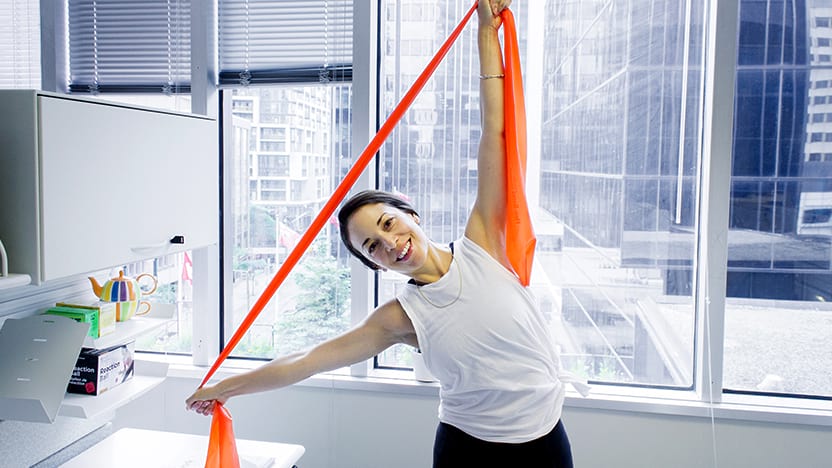
American workers spend about 11 hours of their day sitting, a statistic that’s likely only risen since it was published in a 2011 study in the Journal of Occupational and Environmental Medicine.
As many studies have found since then, the problem with too much sitting is that it can lead to increased risk of certain diseases, like Type 2 diabetes and heart disease.
While there’s not much most of us can do about the amount of time spent sitting in front of computers for work or while commuting, studies recommend breaking up these periods of prolonged inactivity as much as possible.

Some suggestions include walking over to a colleague’s desk instead of emailing or calling them; using a small water bottle or cup that you need to refill more often; or programming an alert on your phone or watch to remind you to get up every hour.
Merrithew® Instructor Trainer Tania Serrano has come up with six stretches that use small props to target the muscles that are often neglected as a result of sitting. All of these stretches focus on mobilizing the upper body, including the thoracic spine and shoulder girdle.
1. Pectoral stretch with Flex-Band
How: Hold the Flex-Band taut between your hands and stretch it across your upper chest to just past your shoulders, keeping elbows slightly bent and angled slightly out and back. Add a gentle upper thoracic extension to increase the opening sensation across the upper back.
Why: This heart-opening stretch is great for releasing the chest and shoulder area, which can get stiff when sitting for long periods of time. The small extension of the thoracic spine will bring awareness to your posture and improve mobility in the mid-back.

2. Wrist mobilization with Flex and Therapy Bar
How: Holding the Flex and Therapy Bar in both hands, extend your arms out in front of you and twist your wrists through flexion and extension.
Why: This rehabilitation tool is ideal for those with carpal tunnel syndrome and typing tension to build strength or rehabilitate the muscles in the hands, wrists and forearms.
3. Standing shoulder mobilization series with Foam Roller™ Deluxe
How: Position the Foam Roller Deluxe behind your back against a wall to partially support your body while completing this series of movements. The pelvis should make contact with the roller, however your head may or may not. Do not force your head to make contact with the roller. Once in position, there are two movements to complete.

A) Arm circles: Slowly circle your arms forwards, upwards and back to your sides, focusing on mobilizing the scapula in all planes of motion, including flexion, upward and downward rotation. Repeat in the opposite direction.
B) Protract and retract the scapula: With your arms stretched out at shoulder height, shoulder width apart, protract and retract the scapula. Widen the shoulder blades away from each other and then gently glide the shoulder blades back towards each other.
Why: These two exercises will help promote mobilization in the shoulder girdle and encourage a release through the scapula, areas that are often frozen in one position while sitting. These exercises will help release stiffness in the upper and mid-back.
4. Thoracic extension with Mini Stability Ball™
How: Hold the Mini Stability Ball between your hands and start with your arms extended, move the ball towards your chest, moving into thoracic extension.
Why: The aim of this stretch is to once again counteract that forward slump to promote openness and mobility in the shoulders and thoracic spine and bring awareness to your posture.
5. Standing side bend (lateral flexion) with Flex-Band®

How: Hold the Flex-Band stretched taut between both hands above your head and slowly bend to one side and then the other, making sure you maintain your head, neck and spine alignment. Your head should remain in the center of your arms.
Why: Since sitting in front of a desk pulls your upper body forward into a rounded position, you want to counteract that by encouraging mobilization in different ways, such as through lateral flexion and extension. This stretch will help you open up the lateral torso and avoid the spine stiffening that comes from prolonged sitting. It also encourages a lengthening of the quadratus lumborum and latissimus dorsi muscles, giving you a great stretch from hips to shoulders. Take some deep breaths as you move into this stretch to expand the diaphragm and lungs.

6. Spinal rotation in chair
How: While maintaining a neutral pelvis and spine, rotate your upper torso to one side of your chair. Make sure you focus on maintaining length in the spine during movement. You can use your opposite arm to aid in the rotation. Repeat on the other side.
Why: This rotation promotes mobility in the thoracic spine, shoulders and upper body, helping to get rid of stiffness.
Let us know your tips for combating sedentary behavior at work in the comments!